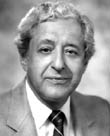| | Principal Investigators
| Mortimer Mishkin, Ph.D. |
 |
|
Dr. Mishkin is
Section Chief of the Section on Cognitive Neuroscience in the Laboratory of
Neuropsychology of the Intramural Research Program, National Institute of
Mental Health, National Institutes of Health in Bethesda, Maryland.
He received an A.B. from Dartmouth College (1946) and an M.A. (1949) and Ph.D. (1951)
from McGill University. His master's thesis was directed by D. O. Hebb,
and his Ph.D. thesis, performed at Yale University, was directed jointly
by H.E. Rosvold and K.H. Pribram. In 1955, after completing his
postdoctoral research with both Pribram at the Institute of Living and
H.-L. Teuber at Bellevue Medical Center, he moved to NIMH as an
Investigator. Dr. Mishkin served as Chief of the Laboratory of
Neuropsychology from 1980 to 1997 and was Associate Director for Basic
Research in the NIMH/IRP from 1994 to 1997. He is currently a Senior
Investigator and his laboratory explores the neurobiological mechanisms
of perception and memory. |
| Research Interests |
|
The Section uses a multidisciplinary approach to investigate the neurobiological
mechanisms underlying learning and memory in primates. In monkeys, the
approach involves: (a) utilizing metabolic mapping techniques, including
both autoradiography and neuroimaging, to delineate the cerebral territory
belonging to a particular functional neural system; (b) studying the
effects of selective lesions within that territory on the performance
of specially designed learning and memory tasks in various sensory
modalities, in the attempt to separate and identify different mnemonic
functions and localize their critical neural substrates; (c)
applying anatomical tracing techniques, to reveal how the different
substrates belonging to a functional family are organized as components
of a neural system or circuit; (d) recording electrophysiological
activity within the identified substrates, to determine the nature of the
information those neurons receive and transmit before, during, and after
learning; and (e) injecting pharmacological agents into those same
substrates, to relate the learning-dependent changes in behavior and
neuronal activity to the underlying cellular and synaptic mechanisms.
The learning and memory mechanisms uncovered in the research on monkeys
serves as the basis for a search for homologous mechanisms in brain-damaged
patients examined both neuropsychologically and with quantitative magnetic
resonance techniques. (The research on patients is conducted in
collaboration with a team at the Institute of Child Health, University
College London.) |
| Representative Selected Recent Publications: |
- Poremba, A., Malloy M., Saunders, R.C., Carson, R.E., Herscovitch, P., Mishkin, M.:
Species-specific calls evoke asymmetric activity in the monkey's temporal poles.,
Nature, 2004, 427: 448-451.
- Poremba, A., Saunders, R.C., Crane, A.M., Cook, M., Sokoloff, L., and Mishkin, M.:
Functional mapping of the primate auditory system.,
Science 2003, 499: 568-572.
- Malkova, L. and Mishkin, M.:
One-trial memory for object-place associations after separate lesions of hippocampus and posterior parahippocampal region in the monkey.,
Journal of Neuroscience, 2003, 23: 1956-1965.
- Varga-Khadem, F., Gadian, D.G., and Mishkin, M.:
Dissociations in cognitive memory: The syndrome of developmental amnesia.,
Phil. Trans. R. Soc. Lond., 2001, B 356: 1435-1440.
- Murray, E.A. and Mishkin, M.:
Object recognition and location memory in monkeys with excitotoxic lesions of the amygdala and hippocampus.,
Journal of Neuroscience 1998, 18: 6568-6582.
- Mishkin, M., Suzuki, W., Gadian, D.G., and Vargha-Khadem, F.:
Hierarchical organization of cognitive memory.,
Phil. Trans. R. Soc. Lond., 1997, B 352, 1461-1467.
|
|
|
|
|
